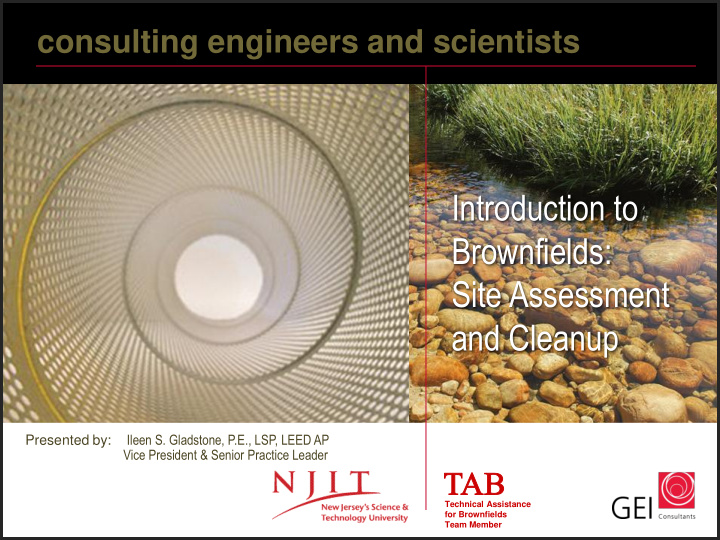



consulting engineers and scientists Introduction to Brownfields: Site Assessment and Cleanup Presented by: Ileen S. Gladstone, P.E., LSP, LEED AP Vice President & Senior Practice Leader TAB Technical Assistance for Brownfields Team Member
What is a Brownfield? • Under-used industrial or commercial properties • Often abandoned because of perceived environmental contamination • Commercial properties • Mills • Warehouses • Factories
Benefits of Brownfields Redevelopment • Protects human health and the environment. • Increases the tax base in the local area. • Restores or replaces dilapidated buildings and facilities. • Strengthens central economic centers. • Creates jobs. • Utilizes existing infrastructure. • Encourages inner city investment. • Reduces suburban sprawl. • Prevents the spread of the contaminants.
Key Players • State Environmental Agencies • State Economic Development and Planning Agencies • Commercial Lenders • Technical and Environmental Consultants • United States Environmental • Protection Agency (EPA) Legal Counsel • • Developers Citizens and Community Groups • Local Community • Development Corporations Local Government Agencies (CDCs) • Federal Government Agencies – HUD – ACOE
Key Challenges • Environmental liability – Manage liabilities associated with contamination • Financial barriers – Additional cost to development – Cleanup costs greater than property value – Lenders hesitant to finance • Cleanup may add to development timeline • Reuse planning
Mills • Operations that uses raw material to manufacture products: – textiles; – pulp, paper, and paperboard; – wood products for construction; – iron and steel for construction. • Process: – cotton, wool, and other raw fibers; – wood and wood fiber, both virgin and recycled; and – iron, ore, coal, and metal scrap.
Characteristics of Mills • Centerpiece of town • Historic structures • Readily accessible to transportation • Existing utilities and infrastructure • Large • Multiple tracts of land • Water bodies and rivers • Opportunity for waterfront development • Long development time periods
Types of Contamination at Mills • Textile – Mercury, polychlorinated biphenyls (PCBs), lead and other metals, volatile organic compounds (VOCs), asbestos, petroleum • Paper mills and wood products – Wood treating chemicals, creosote, VOCs, dioxins, lead, PCBs, petroleum • Iron and steel – Lead, PCBs, petroleum, slag, asbestos • Railroad lines and spurs – Polyaromatic hydrocarbons (PAHs), lead, pesticides • Underground storage tanks (USTs) – Fuel oil
Phase I Due Diligence • Goal: Identify “areas of recognized environmental concerns” • Paper Search • Historic Information • Interview • Site Visit • Areas of Environmental Concern (ACEC) – Historic use, USTs, metal finishing, dry cleaners, types of manufacturing
Sources • Leaking USTs – Fuel – Gasoline – Chemicals • Contaminated fill • Contamination from historic process • Dry wells, drums, dumping • Building contaminants – Asbestos – Lead paint – Mold – PCBs
Media • Soil • Groundwater • Sediment • Surface Water • Soil Gas • Indoor Air • Building Materials
Field Investigation • Subsurface Investigation – Soil borings/test pits/monitoring wells – Soil and groundwater testing – Soil gas testing • Sediment and surface water sampling • Indoor air testing • Building materials
Test Pit Excavation
GeoProbes
Monitoring Well Installation
Water Supply Well Sampling
Soil Vapor Sampling
Indoor Air Sampling
Building Materials • Asbestos – Pipe and boiler installation – Suspended ceiling tiles – Wallboard and joint compound – Caulking and glazing – Mastic – Floor covering and tiles • Lead-based paint • Mold • Mercury
Where PCBs are in Building Materials • Construction between 1950s and late 1970s • Caulking and grout in floor and wall joints • Oil-based paint coating floors and walls • Mastic and adhesives used under flooring (tiles and carpets) • Sealants and finishing used on flooring • Gaskets around windows and doors and in heating, ventilation, and air conditioning systems and ducting • Window glazing • Roofing and siding
What Materials are Likely Affected • Ceilings • Electrical equipment/fixtures • Elevator shafts • Expansion joints • HVAC Equipment • Masonry joints • Painted surfaces • Porous surfaces • Roofs underlying soils • Window and door frames
Cleanup and Development • Remedial Action Plan – Establish Cleanup Goals – Determine if institutional control are required – Estimate Cleanup Costs • Soil Cleanup • Indoor Air • Building Materials – Demolition – Restoration
How to Cleanup a Mill • Soil – Excavation and off-site disposal of soil – Encapsulation – On-site treatment • Indoor air – Vapor intrusion from solvents or gasoline – Sub-slab depressurization systems
Building Cleanups • Abate asbestos, lead paint and PCBs – Significant costs – Asbestos abatements are state regulated – PCB abatements are federally regulated and approved – Remove – Encapsulate • Demolition Debris Management – Abate asbestos, lead paint and PCBs prior to demo – Asphalt, brick, and concrete • Crush and reuse onsite for backfill, grading and roadway bedding
Cohannet Mill, Taunton, MA • Textile Mill • 6.5 acres • 140,000 square feet (sq ft) • Railroad easement – Lead and PAHs • Asbestos in building • USTs and petroleum • Transformer • 64 Affordable residential units • 18,000 sq ft commercial • Riverfront greenspace
Forest City, Cumberland, RI • Phase I and Phase II Due Diligence • Part of Peterson-Puritan Superfund Site • Arsenic, lead, PAHs, oil in soil. Encapsulated to prevent exposure • Deed restriction • PCB-contaminated building debris
MASS MoCA, North Adams, MA • Textile Mill • National Historic Register • 13 Acres • Electronics Manufacturer • PCBs, trichloroethylene (TCE) and heavy metals • Soils excavated and capped • Largest center for contemporary arts • 19 galleries, 100,000 sq ft exhibit space • 60,000 sq ft office and retail
North Dam Mill, Bidderford, ME • Textile Mill • Heart of city’s downtown • Lead-contaminated soil, asbestos, lead paint • Asbestos and lead paint abatement • Soil capping • Residential / commercial
Recommend
More recommend